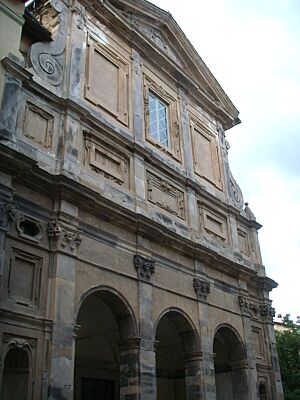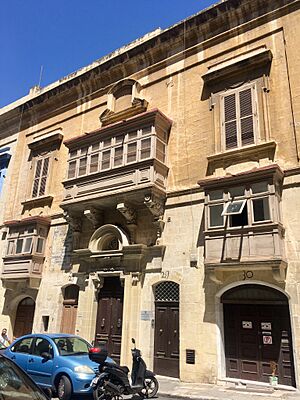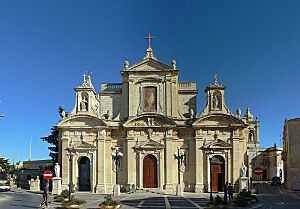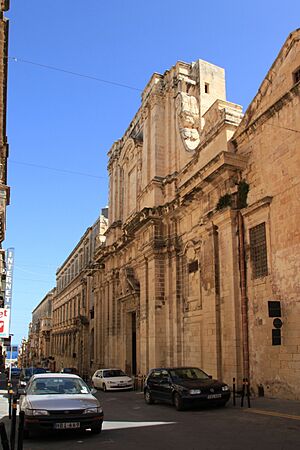Francesco Buonamici (architect) facts for kids
Quick facts for kids
Francesco Buonamici
|
|
|---|---|
| Born | 1596 Lucca, Republic of Lucca
|
| Died | 26 June 1677 (aged 81) Lucca, Republic of Lucca
|
| Resting place | Church of the Suffragio, Lucca |
| Nationality | Italian |
| Education | Accademia di San Luca |
| Occupation | Architect |
| Style | Baroque |
| Parents |
|
Francesco Buonamici (born 1596, died 1677) was an Italian architect, painter, and engraver. He lived and worked in the 1600s, especially in places like Lucca, Malta, Sicily, and Rome. He was very important in bringing the exciting Baroque style of architecture to Malta.
Contents
Who Was Francesco Buonamici?

Francesco Buonamici was born in Lucca in 1596. His parents were Antonio Buonamici and Anna Pistelli. When he was young, he moved to Rome to study. He learned about art and architecture at the Accademia di San Luca.
Some parts of his life are a bit unclear. This is because old records sometimes have different information. Also, he was sometimes called Vincenzo Buonamici by mistake.
He might have started his career in Rome. But after a serious plague in 1630–1631, he worked in his hometown of Lucca. There, he designed the Suffragio church. This church was built where a cemetery for plague victims used to be. In 1634, while in Rome, he also painted scenes for an opera called Il Sant'Alessio.
Buonamici's Time in Malta

In 1635, Buonamici traveled to Hospitaller Malta. He went with Pietro Paolo Floriani, a military engineer from the Pope. Buonamici was meant to stay for only a few months. But he ended up living in Malta for almost 25 years!
The Order of St John hired him. He is often called "the father of Baroque architecture in Malta." This is because he played a huge role in bringing the Roman Baroque style to the island. A famous Maltese architect, Lorenzo Gafà, probably learned from Buonamici when he was young.
Important Buildings and Works
In Malta, Buonamici designed several important buildings. He rebuilt the Church of the Jesuits in Valletta. This church had been damaged in an explosion in 1634. He also redesigned Valletta's Church of St Nicholas and the Church of St Paul in Rabat.
He also worked on other building projects. However, he didn't seem to be involved in building the big forts that were being constructed at the time. Buonamici was also an engraver. He created the title page for a book called Della Descrittione di Malta in 1647.
Working in Sicily and Return to Lucca

While living in Malta, Buonamici sometimes worked in nearby Sicily. He designed or changed buildings in cities like Syracuse, Palermo, Messina, and Trapani. For example, he visited Syracuse in 1650 and 1651 to work for a bishop named Giovanni Antonio Capobianco.
Buonamici left Malta in 1659. He returned to his hometown of Lucca. There, he was named the city's main architect. He helped with changes inside the Church of San Romano between 1661 and 1666. He died on June 26, 1677, when he was 81 years old. He was buried at the Suffragio church in Lucca.
Some people think Buonamici was the father of Giovan Francesco Bonamico, who was born in Malta in 1639. But there is no clear proof of this.
Key Architectural Works
Here are some of the buildings that Francesco Buonamici designed or worked on:
- Church of the Suffragio, Lucca
- Church of the Jesuits, Valletta
- Church of St Nicholas, Valletta
- Hostel de Verdelin, Valletta (people think he designed this)
- Monte di Pietà, Valletta (people think he designed this)
- Triumphal arch and fountains at Ġnien is-Sultan, Valletta
- Church of St Paul, Rabat (finished by Lorenzo Gafà)
- Changes to the palace of Giovanni Antonio Capobianco, Syracuse
- Cappella del Santissimo Sacramento, Cathedral of Syracuse
- Church of Santa Maria della Concezione, Syracuse (possibly designed by him or a relative)
- Courtyard of the Collegio Massimo dei Gesuiti, Palermo
- Front of the Chiesa del collegio dei Gesuiti, Trapani
- Inside of the Church of San Giovanni di Malta, Messina


